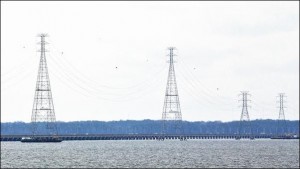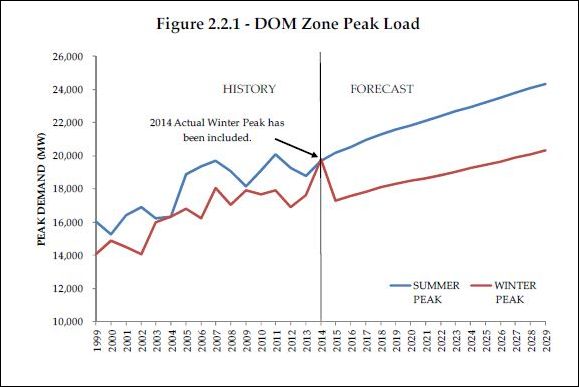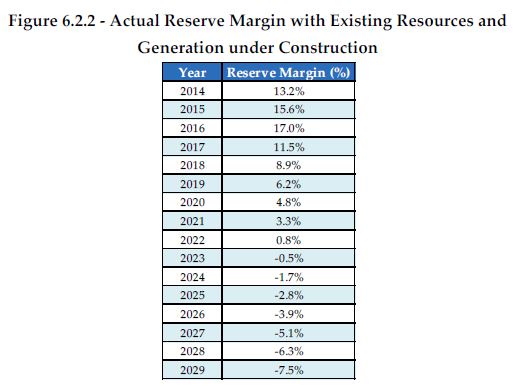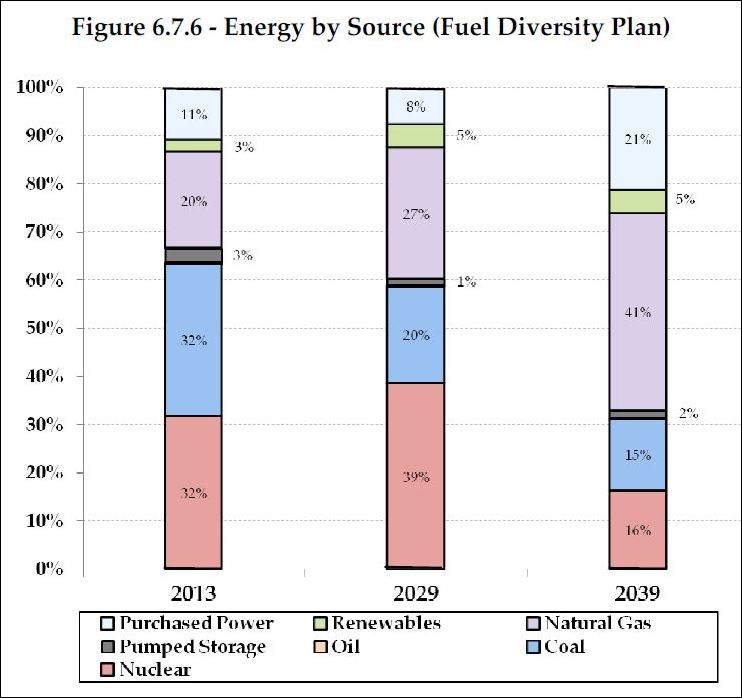by James A. Bacon
Hampton Roads north of the James River could face brownouts or rolling blackouts within two years if Dominion Virginia Power can’t start building a transmission line across the river on a timely basis, the power company informed the U.S. Army Corps of Engineers earlier this month. The Daily Press uncovered the letter in a Freedom of Information Act request seeking recent communications about the project.
“We are running perilously close to an unacceptable service reliability risk that is unprecedented in the modern era here in Virginia,” wrote Dominion project manager Wade F. Briggs in the March 6 letter. If the Army Corps doesn’t clear the way for construction of the power line, he said, “We would need to implement load shed plans in North Hampton Roads which would be unacceptable to everyone concerned.” The purpose of the automatic browns and blackouts would be to avoid overloading the transmission grid and setting off uncontrolled, cascading blackouts.
Northern Hampton Roads, a region stretching from Charles City County to Hampton on the Virginia Peninsula, is served by aging coal-fired power plants that Dominion is phasing out to meet Environmental Protection Agency standards for the release of mercury and other toxic materials. The transmission line would enable Dominion to wheel in electric power from other sources. But it will take 16 to 17 months to build the $155 million line. Dominion has been pleading for delays in implementing the pollution standards. The state Department of Environmental Quality has granted an exemption from the standards through April 2016. A lawsuit filed by opponents to stop the project has been appealed all the way to the state Supreme Court.
The James River power line controversy is significant on its own terms. There are legitimate trade-offs here. There is no denying that the power line would be unsightly, marring pristine vistas of what the first English settlers saw when they sailed to Jamestown four centuries ago. And there is no reason to disbelieve Dominion’s assertion that failure to build the line, which the company has been doing for years, would put the region at risk for economically damaging curtailment of electric power.
But the controversy is also symptomatic of issues facing the entire state — the canary in the coal mine, so to speak, a harbinger of clashes that will become more endemic and more acute over time as Dominion struggles to meet a steadily increasing demand for electricity in the face of stricter environmental rules and resistance to the infrastructure — power lines and gas lines most notably — required to deliver that electricity and the natural gas that fuels it.
The coal plants on the Peninsula will be retired to meet EPA regulations restricting the emission of toxic pollutants. Another wave of EPA regulations likely will phase out all but one of Virginia’s remaining coal-fired power plants within another decade to meet the goal of reducing carbon emissions. A battle new brews over how Dominion will replace that capacity — with natural gas, nuclear or renewable fuel sources such as solar and wind power.
Here’s the backdrop: The long-range forecast in Dominion’s Integrated Resource Plan (IRP), updated annually and filed with the State Corporation Commission, indicates that overall customer demand for energy in its service area will increase by an average annual rate of 1.3% and peak energy (as seen below) will increase at a rate of 1.4%. That growth forecast reflects 17.6% population growth between 2015 and 2029, with commensurate increases of commercial and industrial customers, as well as the increasing use of electric vehicles and hybrid-electric vehicles, which require electric charging. Dominion projects approximately 240,000 such vehicles on the road in its service territory, adding 215 megawatts of additional load and annual energy usage of 853 gigawatt-hours.
Not only does Dominion have to replace the coal- and oil-fired plants, it has to bring on new capacity (or buy it on the open market) sufficient to meet the demands of Virginia’s growing population, economy and electric-vehicle fleet. Failure to add generating capacity beyond that already under construction will result in dangerously low reserve requirements — at least 11% is considered desirable — that could lead to blackouts and brownouts in extreme weather conditions.
How does Dominion propose to meet projected power demand?
Dominion’s IRP presents two plans: a base plan, representing the least-cost path forward, and a fuel-diversity plan, which increases the use of nuclear and renewable fuels. The base plan has two main components: demand-side management (DSM) plans that would reduce the summer peak demand for electricity by 583 megawatts by 2029 and the addition of natural gas generating capacity of more than 4,000 megawatts some time between 2019 and 2029.
Excessive reliance upon a single fuel, natural gas, does present risks, however. As the Dominion IRP states: “An over dependence on any one fuel source is not desirable.” Future prices are difficult to predict. On the one hand, shale gasfields appear to have ample spare production capacity, which is momentarily depressed due to low prices. On the other hand, as former Federal Energy Regulatory Commission Chairman Jon B. Wellinghoff noted in a recentWashington Post op-ed, United States could begin exporting natural gas to Asia and Europe through as many as 14 natural gas-export terminals. That’s good news for the U.S. economy. But, he warns, “For Virginia ratepayers, that means a cheap, local commodity will become an expensive, global commodity.”
Diversifying the utility’s fuel mix will be made more difficult by the shutdown of three nuclear units at Surry and North Anna in the early 2030s. Dominion’s fuel-diversity plan calls for construction of another nuclear unit in North Anna, which would bump up nuclear’s contribution by 2029 before a sharp decline in the following decade, plus the development of wind- and solar-energy capacity. Under the fuel-diversity plan, the fuel mix would evolve as shown below:
This plan represents Dominion’s preferred strategy for balancing the goals of lower cost and reduced pollution/carbon emissions, but it would fall significantly short of the state’s voluntary Renewable Portfolio Standard: generating 15% of electricity from solar, wind, hydro or biomass by 2025. Therefore, the plan does not meet the expectations of environmental organizations who, incidentally, also tend to disapprove of nuclear power.
Dominion and its customers are in a bind. There are major obstacles to every fuel alternative. Coal and oil are being phased out for reasons of cost (natural gas is cheaper…. for now) and the environment (they are the dirtiest fuels). Nuclear will increase over the mid-term if the proposed North Anna plant is constructed — although that’s no sure thing, given environmentalists’ opposition to it — but will decrease over the long term as aging plants are shuttered. Natural gas is the preferred fuel for the moment — it’s cheaper and cleaner than oil and coal — but excessive reliance upon the fuel makes Virginians vulnerable to spikes in price when economic conditions change.
That leaves renewables and purchased power to take up the slack. The great advantage of renewables is that the fuel comes free. But at present they have higher up-front capital costs, and they present major issues of reliability. Environmentalists aren’t legally bound by a commitment to ensure reliable electric service; Dominion is. The problem with wind and solar is that both are intermittent power sources. Solar plants don’t generate electricity when the sun goes down or when clouds block the sun. Wind turbines don’t generate electricity when the wind doesn’t blow, or when it blows too hard.
Dominion has two options for providing backup power to renewables: building additional gas-fired plants, which, unlike coal and nuclear, can rapidly adjust output, or purchase the power on the open market, delivered over high-voltage electric lines.
Adding gas-fired capacity that sits idle much of the time is inherently expensive, negating renewables’ cost advantage of zero fuel prices.
The other alternative is purchasing power on the open market. Dominion participates in the PJM organization that coordinates the operation of the electric grid serving 60 million people in 14 Mid-Atlantic and Midwestern states. Dominion currently purchases about 13% of its electricity, most of it through PJM. Here’s the catch: Wheeling large volumes of electricity from other states requires a robust network of transmission lines. For understandable reasons, nobody likes building new transmission lines in their back yard.
Dominion backed off a proposal to build a transmission line through Virginia’s northern piedmont several years ago, and now it faces legal challenges with the James River power line. Any effort to build more high-voltage transmission lines, with their intrusive towers and invasive right-of-way, inevitably will inspire the same kind of resistance.
The simple fact is that there are no easy answers for supplying Virginia’s increasing energy needs while simultaneously reducing CO2 emissions and avoiding brownouts and blackouts. Likewise, there is no broad consensus on how to move forward. That’s why the drama playing out in Hampton Roads could be prelude to conflicts that will break out across every corner of Virginia over the next ten years.






